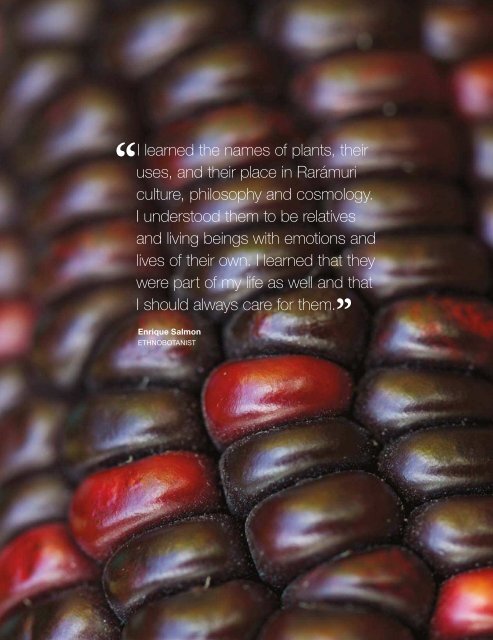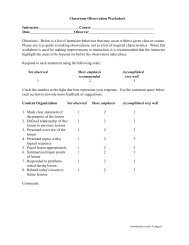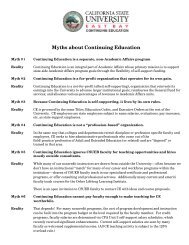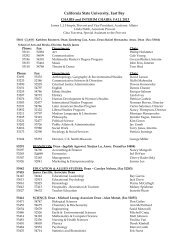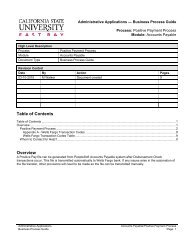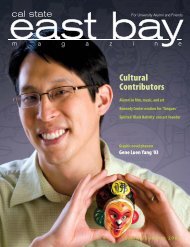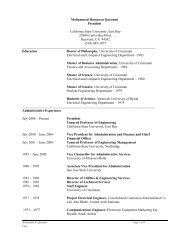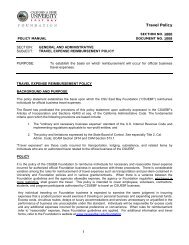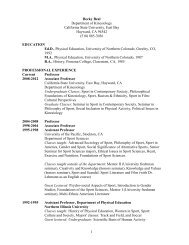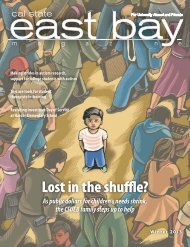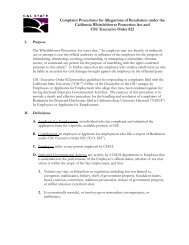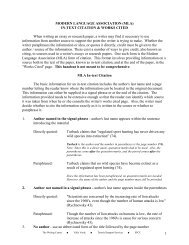Fall 2011 - California State University, East Bay
Fall 2011 - California State University, East Bay
Fall 2011 - California State University, East Bay
You also want an ePaper? Increase the reach of your titles
YUMPU automatically turns print PDFs into web optimized ePapers that Google loves.
features<br />
“<br />
I learned the names of plants, their<br />
uses, and their place in Rarámuri<br />
culture, philosophy and cosmology.<br />
I understood them to be relatives<br />
and living beings with emotions and<br />
lives of their own. I learned that they<br />
were part of my life as well and that<br />
I should always care for them.<br />
”<br />
Enrique Salmon<br />
ethnobotanist<br />
techniques. The consultant taught them a method called<br />
waffle gardening.<br />
“Around the edge of this 6-by-6 foot plot, you build<br />
little walls out of soil about 8 inches tall,” Salmon explains.<br />
“You look at it from above, and it looks like a waffle.”<br />
The miniature walls do two things: stop the wind from<br />
blowing the soil away and drying it out, while helping create<br />
and retain just enough moisture to nurture the plants.<br />
The ancient gardening technique is allowing the Pueblo<br />
to again cultivate traditional foods while also nurturing<br />
their once-fragile culture.<br />
“They wanted to get to the point where they could feed<br />
themselves as a people,” Salmon says. “When I was there<br />
working with them, they were already able to feed their<br />
kids in the schools and the elders in the community center.<br />
That’s another example of resilience and adaption.”<br />
Technology Hopi-style<br />
Salmon also expressed regard for Hopi farmers he<br />
worked with, who demonstrated a gift for holding onto<br />
their customs — and, therefore, their Hopi identity — while<br />
integrating them with new ways, particularly technology. He<br />
points to an older Hopi farmer named Eric Polingyouma,<br />
with whom he developed a strong relationship.<br />
“If my book were a novel, which it isn’t, he’d be a<br />
main character,” says Salmon, clutching a digging stick<br />
that Polingyouma gave him. Salmon demonstrates its use<br />
by bending over and, with one hand rotating the polished<br />
blonde wood inlaid with shiny blocks of blue stone,<br />
pantomimes digging into the ground and dropping maize<br />
kernels into furrows.<br />
Today, Polingyouma, an octogenarian living with his<br />
wife Jane, use a small tractor the size of a riding lawnmower<br />
to plow his fields in a Hopi community in Arizona. While<br />
he’s glad to take advantage of 21 st -century agricultural<br />
technology, he nonetheless uses a tractor in what Salmon<br />
calls a “Hopi way.”<br />
“Eric wouldn’t go just buy farm implements and use<br />
them straight out of the box,” Salmon says. “He would juryrig<br />
it to be the way a traditional Hopi farmer would farm.”<br />
In other words, he customizes the tractor’s attachments<br />
to accommodate digging sticks, a practice that lets him<br />
continue growing his traditional crops, such as corn, feeding<br />
his household, while retaining his Hopi sense of self.<br />
Salmon says the Hopi people have a ritual for<br />
everything, from marriage rites to corn dances. Many foodoriented<br />
traditions and ceremonies for the indigenous<br />
people of North America, as evidenced by prehistoric rock<br />
art in Mexico, date to as early as 400 BC to 50 AD.<br />
“The people (already) were beginning to link their<br />
identity and their morals to how they impacted the<br />
landscape,” writes Salmon about the cave drawings.<br />
In modern industrialized cultures, he says, many<br />
people are disconnected from not only the land but the<br />
steps involved in cultivating — and sometimes preparing<br />
— the strawberries, broccoli, and chicken that make their<br />
way to a family’s dining table. This disconnection from<br />
our food’s origins contributes to declining stewardship of<br />
the environment.<br />
“You talk to people today who have no idea what an<br />
avocado tree looks like,” Salmon says. “The point is: We<br />
have no relationship with food (sources), with plants, with<br />
our identity.”<br />
Future solutions<br />
A society with weak ties to the source of its food,<br />
the land, can lead to less than attentive caretaking of the<br />
environment, Salmon says.<br />
“The result is all these negative impacts we’re having<br />
in the air, the waters, our oceans, our food. Even (on)<br />
our front and backyards we spray poison. The things<br />
modern industrialized society does to our land would be<br />
unthinkable to most indigenous people.”<br />
In Rarámuri, for instance, there’s no word for poison or<br />
poisonous, he points out.<br />
In forecasting and planning for the future health of the<br />
global landscape, Salmon acknowledges that food ranks as<br />
only one of many concerns.<br />
“… But it is an essential one when we consider<br />
how we will adapt to global warming, which will include<br />
foods that can withstand droughts, higher temperatures,<br />
and other extreme climatic changes,” he writes in Eating<br />
the Landscape.<br />
The solutions, he adds, one day may be found in the<br />
tiny fields of resilient American Indian farmers. n<br />
features<br />
16 Cal <strong>State</strong> <strong>East</strong> <strong>Bay</strong> Magazine | FALL <strong>2011</strong> Cal <strong>State</strong> <strong>East</strong> <strong>Bay</strong> Magazine | FALL <strong>2011</strong> 17


